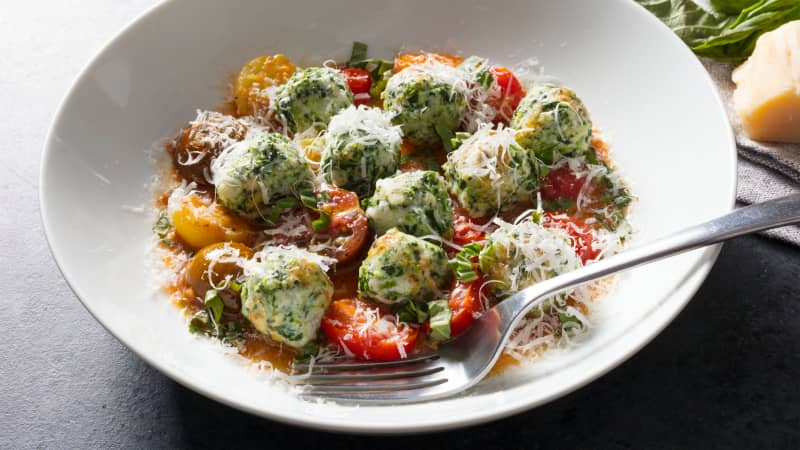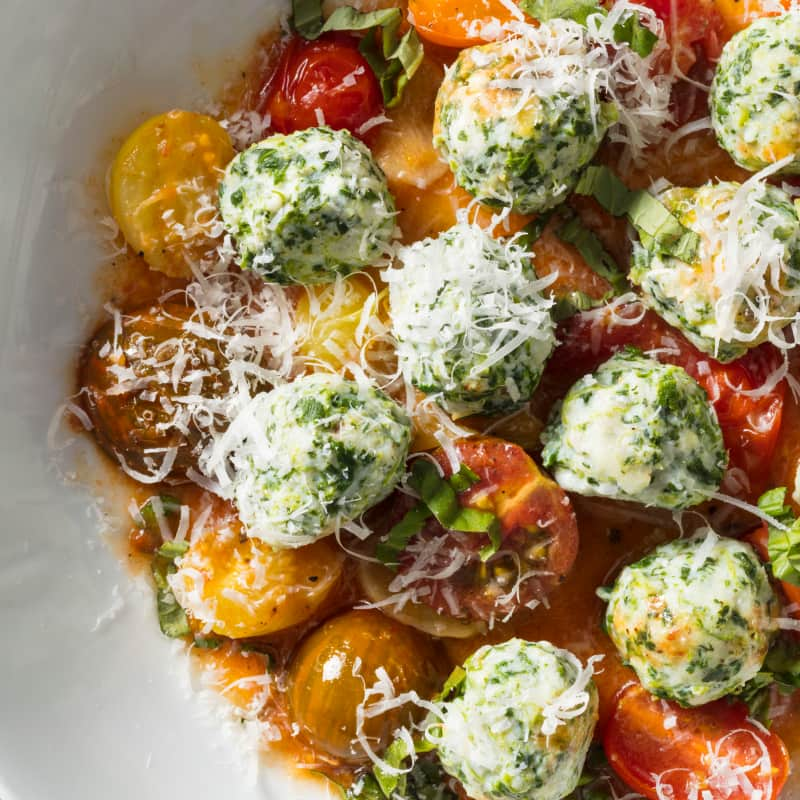Italian cooks came by gnudi the way other cooks in that part of the world came by panzanella and pappa al pomodoro—which is to say by necessity more than by design. They patched together the soft, fresh cheese and greens (usually chard or spinach) that were abundant in pastoral pockets of Tuscany, binding them up with egg, flour and/or bread crumbs, grated Parmesan or pecorino, and seasonings. When the dough was adequately cohesive, they molded small portions into round or cylindrical dumplings; gently poached them in salty water; and sauced them with something simple, such as tomato sugo or browned butter.
Making Light and Tender Gnudi
Published Dec. 7, 2020.

What’s in a Name?
Italian dumplings go by a variety of names depending on the preparation and the region—and which legend you prefer. The kind made from ricotta and greens are variously called gnudi, referring to their appearance as “naked” ravioli filling; malfatti, a nod to their inconsistent, “badly formed” shape; and strozzapreti, or “priest stranglers”—a title some link to a tale about a hungry priest who ate them so voraciously that he choked.
This was cucina povera at its best: a couple of naturally paired provisions deftly worked into something substantial and satisfying. And while the name of the dish suggests a certain deficiency, the dumplings’ appeal is arguably thanks to—not in spite of—the absence of pasta dough. (“Gnudi” literally means “nudes,” referring to the way they seem like ravioli filling without the wrapper. They’re also known as malfatti and strozzapreti; for more information, see “What’s in a Name?”) In fact, Italian food scholars such as Oretta Zanini De Vita have traced praise for gnudi as far back as the 13th century. In her Encyclopedia of Pasta (2009), Zanini De Vita notes that the Franciscan friar and chronicler Salimbene da Parma “. . . tasted gnudi for the feast of Saint Clare and considered them a true delicacy.”
At the same time, it must have taken practiced hands to turn out the tender, verdant dumplings that still make up the dish today. I stumbled through my first batches as I confronted the dish’s universal challenge: water management. Both the ricotta and the greens are loaded with moisture, much of which must be removed lest the dough be too difficult to handle or require so much binder that the dumplings are leaden instead of light.
Fast Track to Water Management
The two key components in gnudi, greens (usually spinach or chard) and ricotta, contain loads of water that must be removed so that the dough isn’t too wet and sticky to handle or too loose to form cohesive dumplings. All told, our techniques eliminate nearly a cup of water.
“TOWEL-DRY” RICOTTA
Letting the ricotta sit in a paper towel–lined fine-mesh strainer is a common method for removing its whey, but it can take up to 10 hours to drain off just a few tablespoons. “Towel-drying” the cheese in a thin layer on a paper towel–lined rimmed baking sheet creates more surface area to remove just as much liquid in about 10 minutes.
Method:
Line rimmed baking sheet with double layer of paper towels. Spread ricotta in even layer over towels and set aside for 10 minutes. Grasp paper towels and fold ricotta in half; peel back towels. Rotate sheet 90 degrees and repeat folding and peeling 2 more times to consolidate ricotta into smaller mass. Using paper towels as sling, transfer ricotta to bowl.
USE FROZEN SPINACH
Ridding raw spinach of excess moisture is often done by blanching the leaves, which damages their cells and releases their water. But there’s a much simpler way to get this result: using frozen spinach. Freezing spinach turns its water into jagged ice crystals that break the cells open; when the spinach thaws, the water practically pours from the leaves and can be easily wrung out with your hands.
Method:
Divide spinach (frozen whole leaf, thawed) into 3 or 4 portions. Gather 1 portion in your hands and squeeze out as much liquid as possible. Repeat with remaining portions.
Michael Pagliarini, chef-owner of Giulia and Benedetto restaurants in Cambridge, Massachusetts, underscored the latter risk for me, noting that cooks must tread carefully when it comes to binders if they don’t want dense results. Jody Adams, a Boston-area chef best known for her restaurants Porto, Trade, and (now-shuttered) Rialto, echoed that sentiment.
“[There’s a] physical challenge to getting it right,” she said of the dough. “[There should be] just enough firmness that it doesn’t disintegrate . . . but [it should be] really airy.”
Making Light of the Dough
To tackle the water issue, most recipes suggest draining the ricotta in a paper towel–lined strainer and blanching the greens (I was using fresh spinach) before squeezing out as much water as possible. I had no trouble with either technique, except efficiency. It took hours for the cheese to drain sufficiently and multiple batches of blanched spinach to yield enough for four servings of dough. Ultimately, I changed tack on both: I “towel-dried” the ricotta on a rimmed baking sheet for 10 minutes and used frozen spinach, which simply needed to be thawed and dried in a single batch (see “Fast Track to Water Management”).
From there, I chopped the spinach in a food processor and transferred it to a bowl with the drained ricotta. Then I seasoned the mixture with Parmesan, salt and pepper, and lemon zest and started experimenting with binders. I needed just the right balance of eggs and starch: Egg proteins hold the dough together as it cooks, but eggs also add water; starch from flour and/or bread crumbs absorbs water, firming the dough and making it easy to manipulate, but too much can lead to dense results.
The Scoop on Scooping
The texture of cooked gnudi can mostly be predicted by the consistency of the raw dough. A mixture that is firm enough to be rolled into ropes and cut into pieces (like gnocchi dough) tends to contain more binder and cook up rather dense. This dough, which is just cohesive enough to scoop and roll into balls, cooks up light and pillowy.
Case in point: I made a beautifully workable dough with a pair of egg whites (more valuable than yolks for their preponderance of binding proteins) and a little more than ½ cup of flour. I rolled it into tidy ropes and cut the ropes into small pieces as I would gnocchi—the shaping approach I’d seen in several recipes. But the cooked dumplings were dense and tight.
I could have kept fiddling with the ratios, but instead I solicited ideas from Lydia Reichert, a friend of mine who is the former chef at Sycamore in Newton, Massachusetts. She offered a clutch suggestion: Instead of making a dough that’s firm enough to roll, make one that’s just cohesive enough to scoop and roll into rounds (see “The Scoop on Scooping”).
To do that, I had to cut back on some of the flour without removing so much starch that the dough became sticky. And as it turned out, that was a perfect job for the bread crumbs I’d seen in some gnudi recipes: Just 1 tablespoon of conventional crumbs in place of an equal amount of flour produced a light but cohesive dough and noticeably airier gnudi, since they made the dough heterogeneous, much as they would in a meatball mixture. The results were even better with panko; these coarser crumbs are more absorbent and made the raw dough easier to handle.

Two Traditions Become One
Bright tomato sugo and rich browned butter are classic gnudi sauces, but I was intrigued by the thoughtful, less traditional riffs I’d seen and ended up making something of a hybrid. I browned some butter, toasting thinly sliced garlic in it as I swirled the pan, and then added halved cherry tomatoes along with a splash of cider vinegar. I cut the heat and covered the pan so that the tomatoes collapsed and spilled their bright juices into the butter—almost like tomato confit. Fresh basil and grated Parmesan over the top made the whole ensemble pop and placed my take on this dish just where I wanted it: comfortably wedged between traditional and personal.

